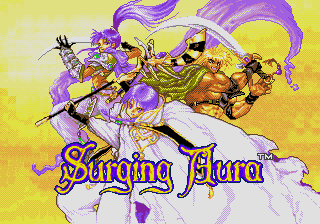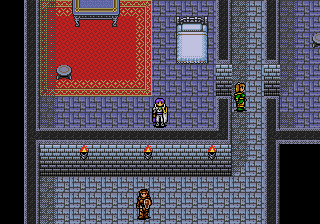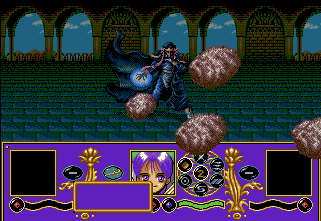Main
What's
New
Import Stores
Import Reviews
Import Cover Archive
Special Features
Games
The Top
100
Video Game Fiction
Wanted!
Acknowledgements
Forum
Links
Import Stores
Import Reviews
Import Cover Archive
Special Features
Games
The Top 100
Video Game Fiction
Wanted!
Acknowledgements
Forum
Links



Let me begin with a header on an advertisement from Sega - "Live Out Your Fantasies with Role Playing Games from Sega, the Leader of RPGs". This was back in the time when Shining In The Darkness was released (an awesome dungeon crawler-styled RPG), and after Phantasy Star II won video game of the year by Video Games and Computer Entertainment magazine. So then, what happened to Sega? Later into the Genesis lifecycle they began ignoring the RPG market, claiming that it wasn't worth Sega of America's effort. What was interesting to note was that in Japan circa 1994, there were two RPG titles going head-to-head for the honor of RPG of the year - Final Fantasy VI (Square) and Phantasy Star IV (Sega). Both are great games that deserved attention. During the period they were to be released in America, FFVI was getting more attention and hype than PSIV and this (in 100% truth) was unfair to Sega since they predetermined Square's title to be RPG of the year. Even if you felt that FFVI was better, PSIV was a landmark title for Genesis owners everywhere and, if it was given more attention, could've boosted Sega sales (and confidence, apparently). Since FFVI recieved unprecedented coverage, with PSIV being forced to play keep-up... Sega lost the race.
Which means we never got Sega/Mutsumi Inomata's Surging Aura, a fun spinoff of the Phantasy Star series. As a matter of fact, besides a slightly changed battling system, it uses the same game engine as PSIV. The game opens with some rather tasty artwork in the vein of other Sega RPGs. Strange enough, it feels like something out of Sonic Software Planning - the look, the music, the presentation, etc. It's all so similar. After a rather stellar opening sequence with cinemas interlaced within, the quest begins. Unfortunately I don't know what the story is about (I don't understand Japanese) but it has something to do with books that kingdoms are after (not unlike Ys). The main character is a magician that winds up being joined by an assorted crew of people, including a pirate, a couple male and female warriors, etc. but there is only a maximum of two with you at any given time. You gain magic by either finding it in chests, having somebody give you it, or buying it. Here's the thing; only the main character can use magic and everybody else can only do standard things (attack, defend, items, etc.) The battle system is slightly changed from PS series in that you see the character faces and underneath the HP/MP is displayed like an energy bar. There are commands shown and when you select one it begins to build. Upon completion the desired command is executed. What's annoying is when you want to cast certain spells. You select a spell from one of six orbs (I guess that's what they are) and you watch the spell being cast (like in Final Fantasy II for SNES). But if your main character gets hit the spell casting will halt momentarily. During this small interval of time, if he's hit again the spell is cancelled and you'll have to re-decide what you want to do. Fortunately, the enemy must follow the same procedure for casting spells. But unfortunately for you, sometimes there are two rows of enemies - one in the front row and one in the back - and in order to attack the ones in the back you'll need to do one of several things in time; A) kill off all the front row enemies so it forces the back row to come forward, B) use a long-range weapon, or C) get off a magic attack in time. It's a great idea for strategy in an RPG, but it's not done as well as it should've been.
The game itself is your generic RPG adventure. You go from town to town with very little backtracking, and almost every town looks the same. There are castles and such, but even here they look too similar to one another. It's not a big issue as far as i'm concerned. The game is very easy to understand even if you don't know Japanese. Some spots will make you go "Hmmm..." but with all the battling you'll do, you're sure to be a powerhouse for whatever else comes your way by the time you've figured out what to do next. There's a generous assortment of baddies and most are designed very well (as are the backgrounds) but they don't animate. Also, if you're in favor of PS-style cutscenes during the game, you won't find them here. What you've got here is generic RPGing in the style of PS but not quite on the same level.
The music is very similar to games like Shining Force and Shining In The Darkness with some great tracks here and there. It's got that old classic Sega feel about it which i'm in favor of. The sound effects are done quite well too. A good effort aurally.
Looking back at an old editorial in Sega Visions magazine (Fall 1991 issue), i'm reminded of why I am a game player to begin with. Excerpt: "Our games are always breaking technological ground, testing the waters of new techniques, and blasting past creative limits. You're playing video games for a good time, right? And that's exactly what Sega's technically complex, creatively outrageous games deliver." That may have been true in 1991 when Sega was putting their feet in the door, but how much changes in just a few years. I recommend Surging Aura for those of you that want to play something that will stimulate Sega nostalgia, but don't go into it thinking you'll be blown away.
- Michael